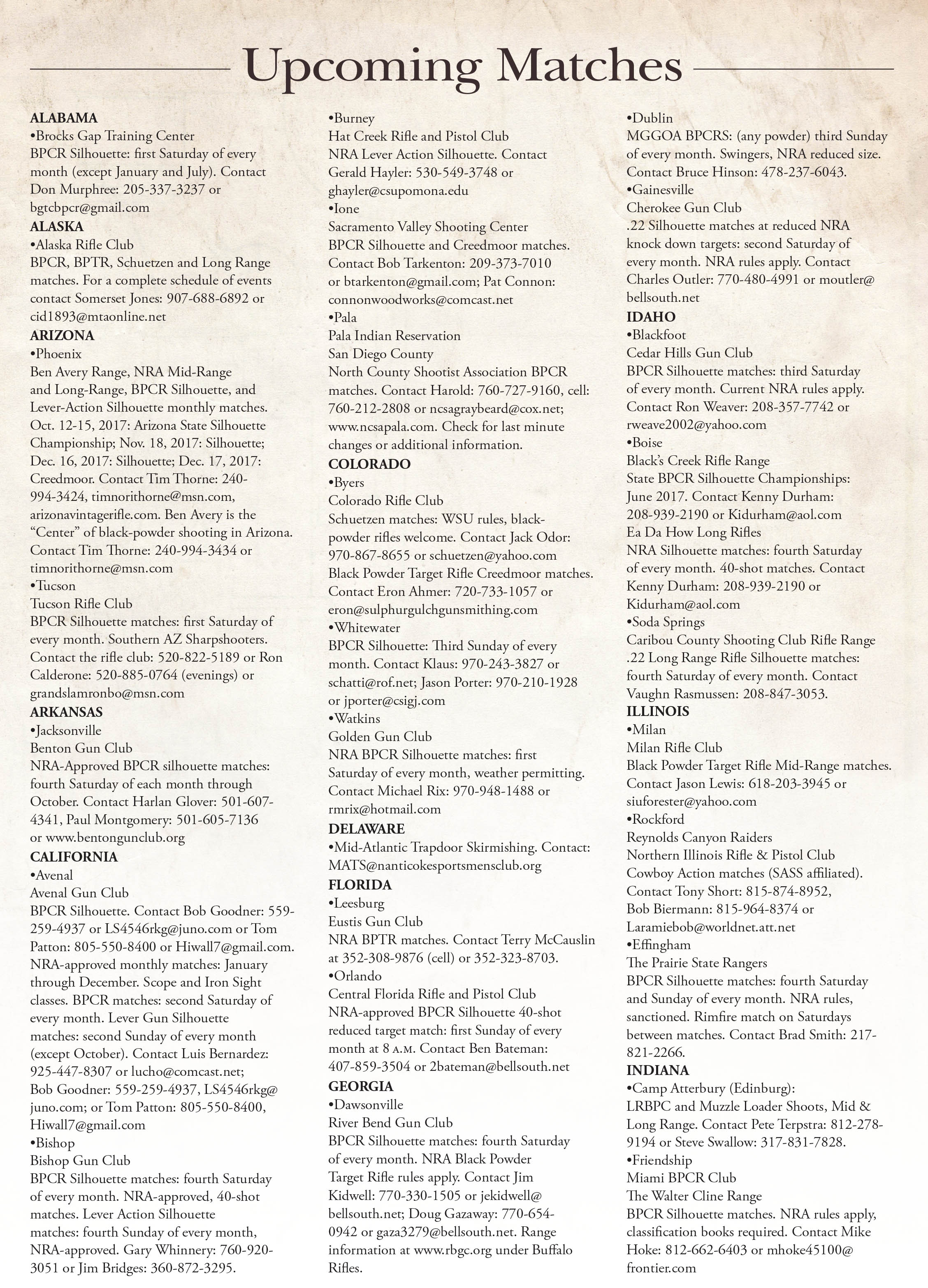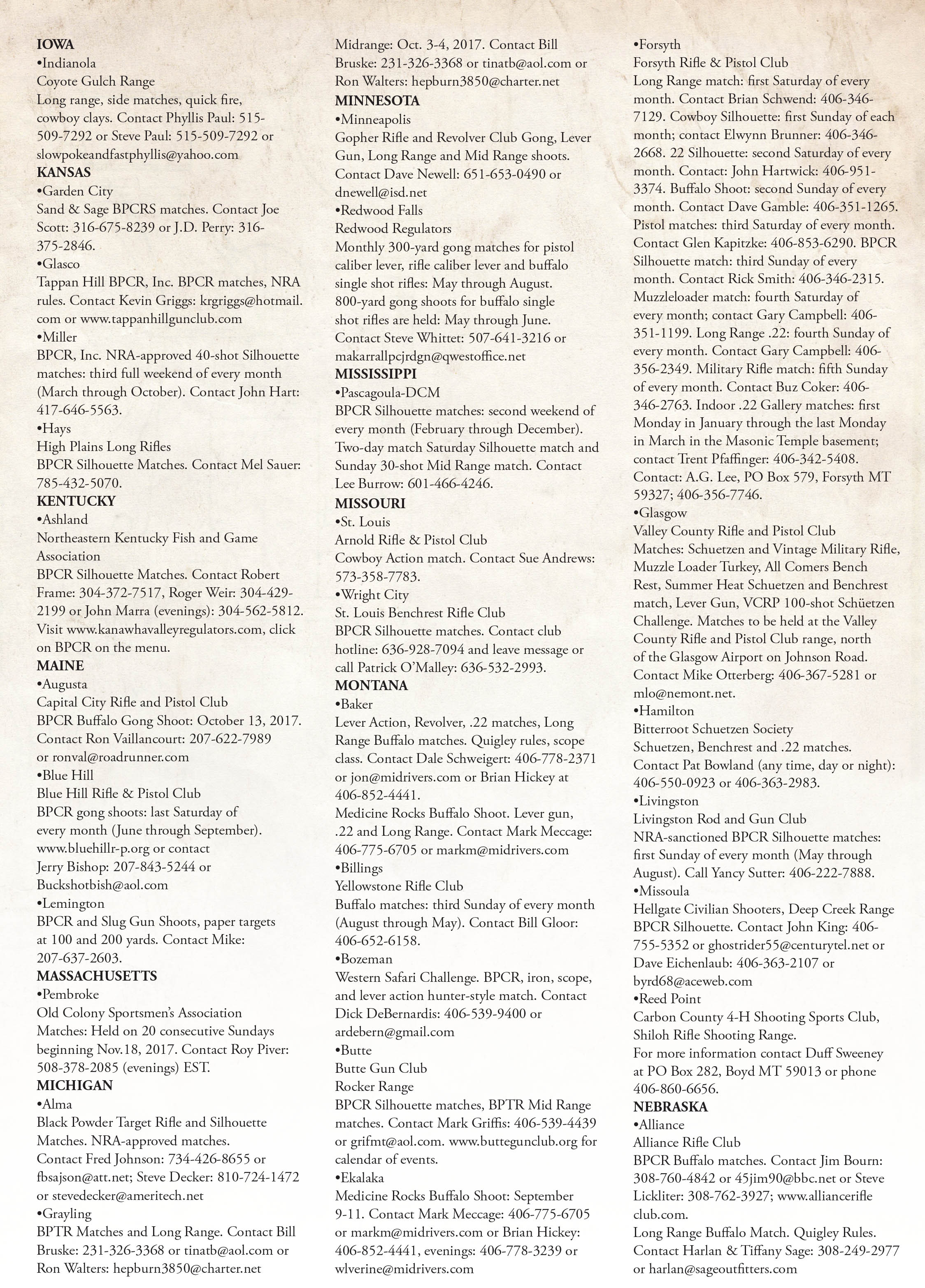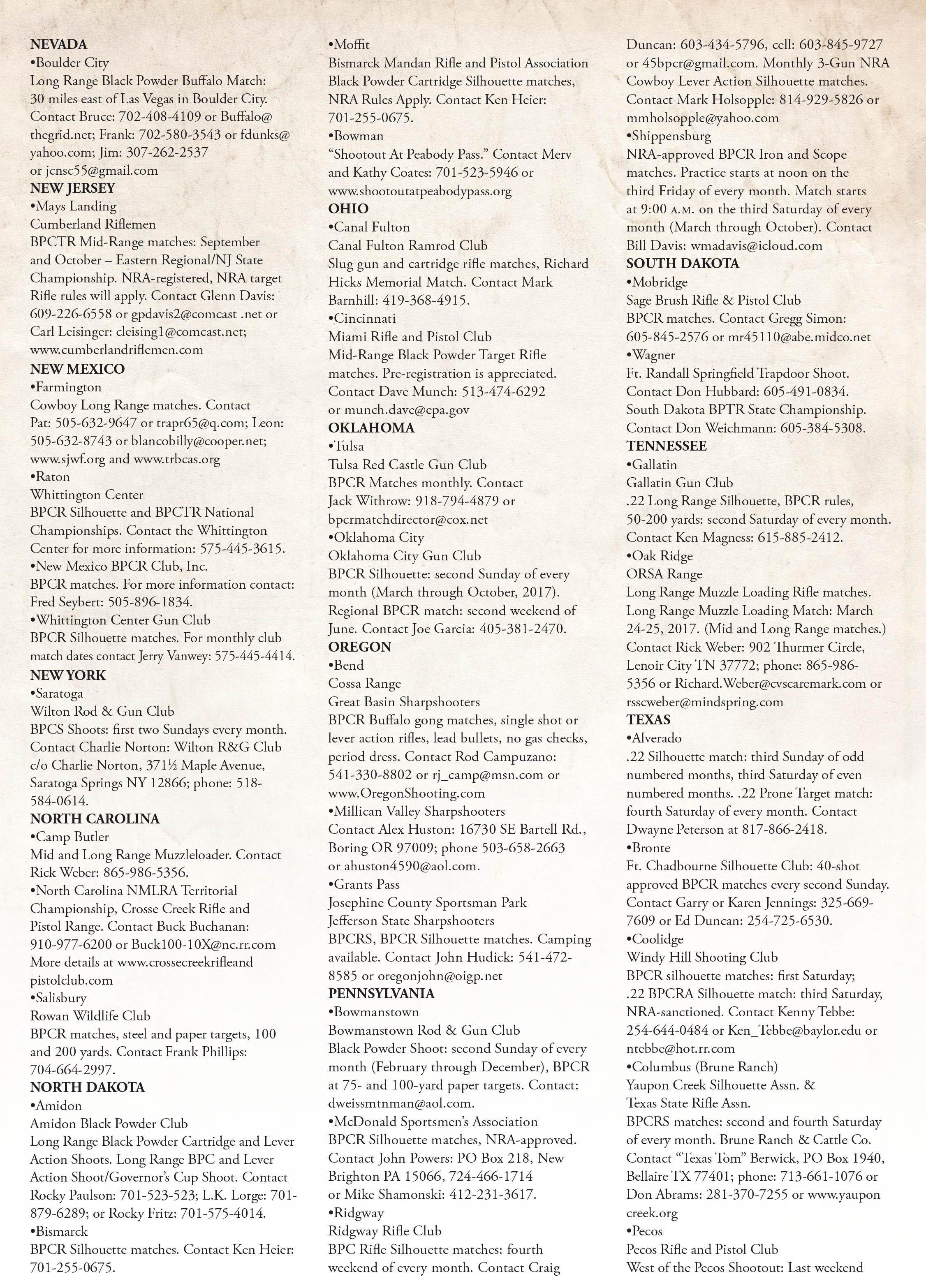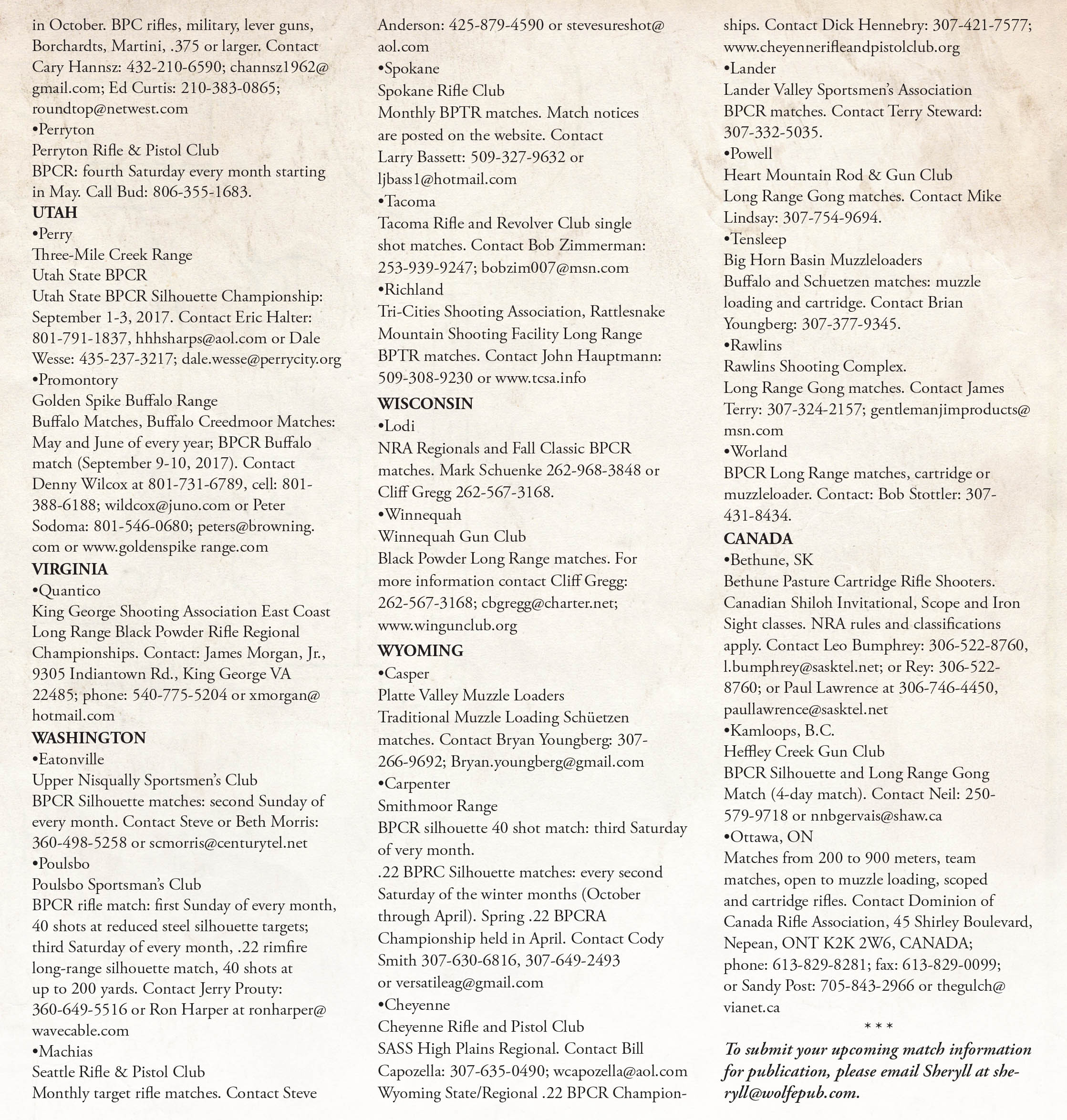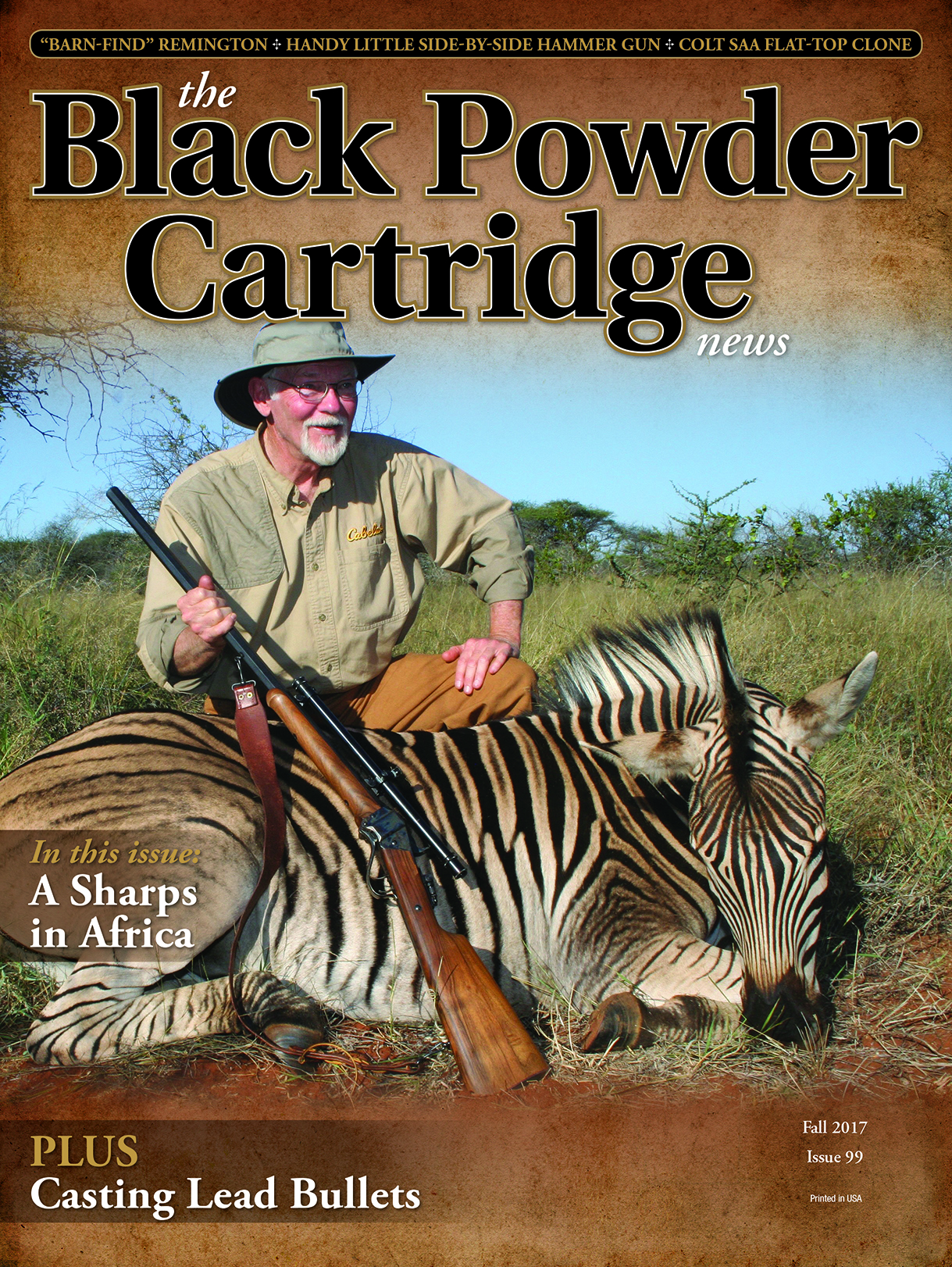Match Results
Ray Hanson Wins Long Range Muzzeloading National Championship 2017
column By: John Ciccone | October, 17
Member USIMLT, Long and Short Range Teams
Ten shooters gathered at Camp Butner, North Carolina, on June 4-7, 2017 to test their marksmanship in what is probably the most demanding of rifle disciplines – long-range muzzleloading. The match served as a
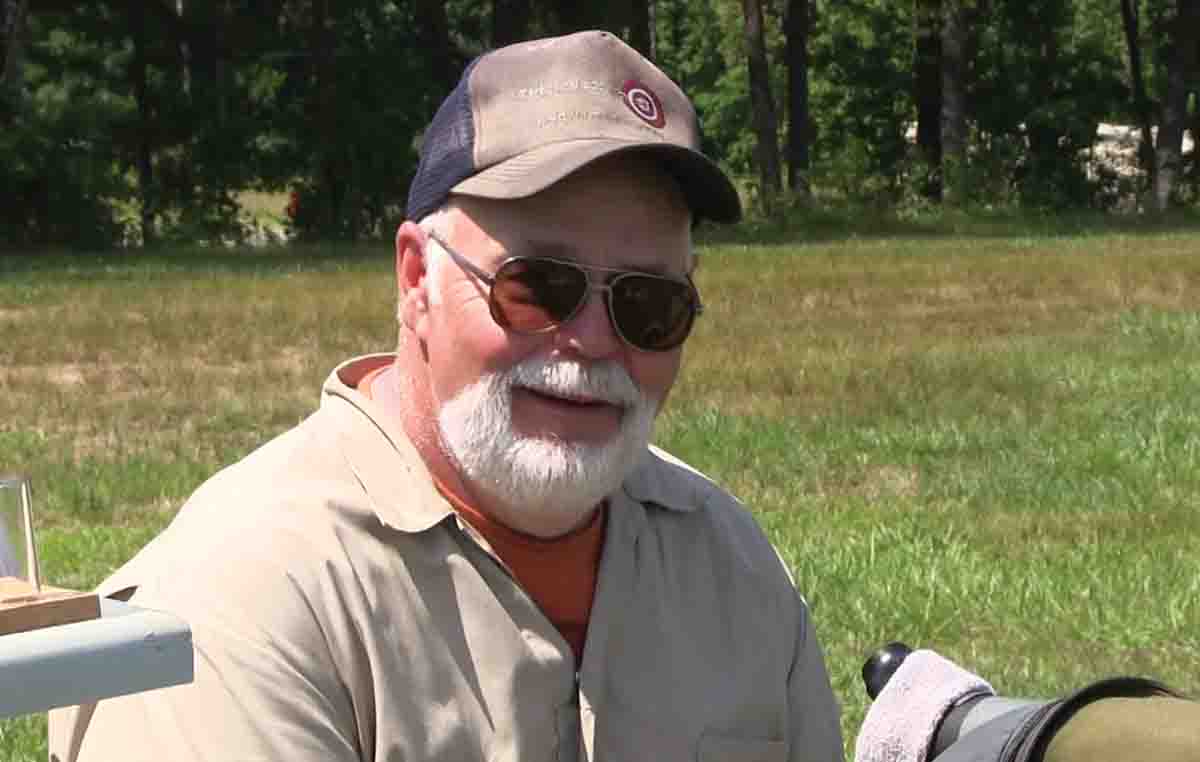
preliminary to the 11th Muzzle Loaders Associations International Confederation (MLAIC) World Long Range Championships in Adelaide, Australia coming this October.
Shot at distances from 300 to 1,000 yards, only those who show consistency in shooting technique, cleaning, loading, bullet casting, and most important, properly doping wind shifts, are rewarded with success.
Generally moderate weather conditions prevailed, with temperatures ranging from 70 degrees Fahrenheit in the morning to 80 or 90 F by midafternoon. Winds mercifully shifted lightly with only a few real reversals . . . going from 2 minutes right to 4 minutes left, for example. But, depending on the direction of the wind, even a 2 mph change in velocity or a slight shift can blow you off target at a thousand yards if you don’t pick it up. “Of 30 or so shots, I moved my sights three quarters of the time,” said Ray Hanson, of Twin Valley, Minnesota, match winner and team co-captain.
Once a year, the United States International Muzzle Loading Team holds its National Championships. “We shoot the match exactly like a World Championship – targets, rules, and courses of fire,” said Ed Decker, Captain and Coach of the U.S. Team. This is an opportunity for anyone who would like to learn about international muzzle loading competition.
Each country is allowed to field teams with 16 shooters using reproduction firearms and an unlimited number of original arms. Most countries make their shooters qualify to be able to travel to a World Championship. Not so the United States; we allow anyone who wants to participate. “This lets less accomplished shooters get experience in the individual matches with the hope they will develop into a good team shooter,” said Decker.
Coaching
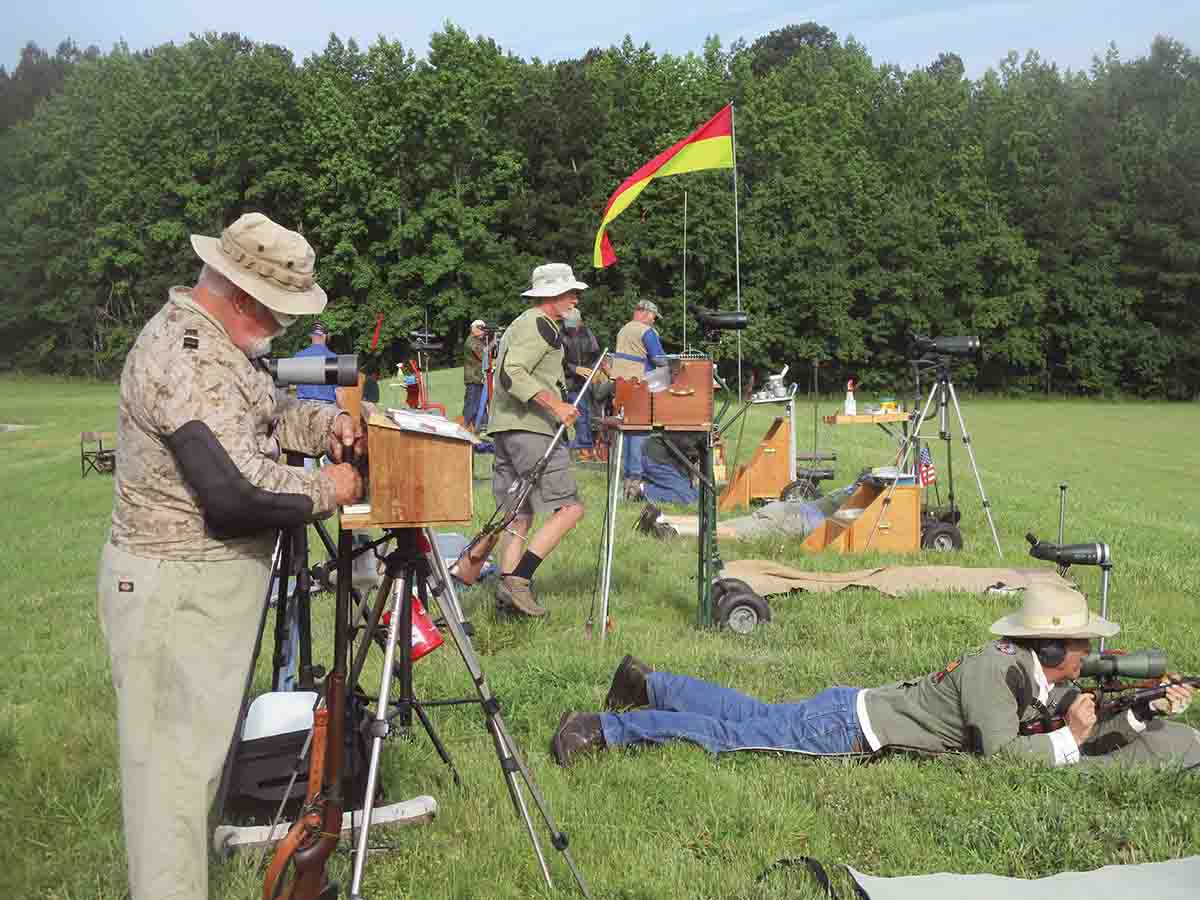
One of the goals of the U.S. Team is improving the skills of individual shooters. Following the match, the more skilled shooters coached and helped diagnose problems of less accomplished shooters. “This was useful for both of us,” said Hanson. “In one case, the shooter I coached was wrapping his paper patch bullets incorrectly, actually overlapping the paper. This resulted in an unbalanced bullet. He was also not shooting with a spirit level. While you may be able to get away with that at 300, you certainly can’t at 1,000. If you are .001 inch out of plumb it will put you off a minute … that’s 10 inches at 1,000 yards. So, we were able to give him some guidance with his loads and equipment that should help him in the future,” Hanson said.
Looking Forward to the World Match in Australia
The Nationals match afforded Decker and Hanson the chance to make preliminary evaluations of shooters for assignments to the Mid Range and Long Range four-man team matches that are subdivisions of the competition. The 11th MLAIC World Long Range Championships will be held October 8-14, 2017 near Adelaide, South Australia.
“We have a good chance of bringing back the gold, particularly in the Long Range Team event,” said Decker, the captain and coach for both the Mid Range and
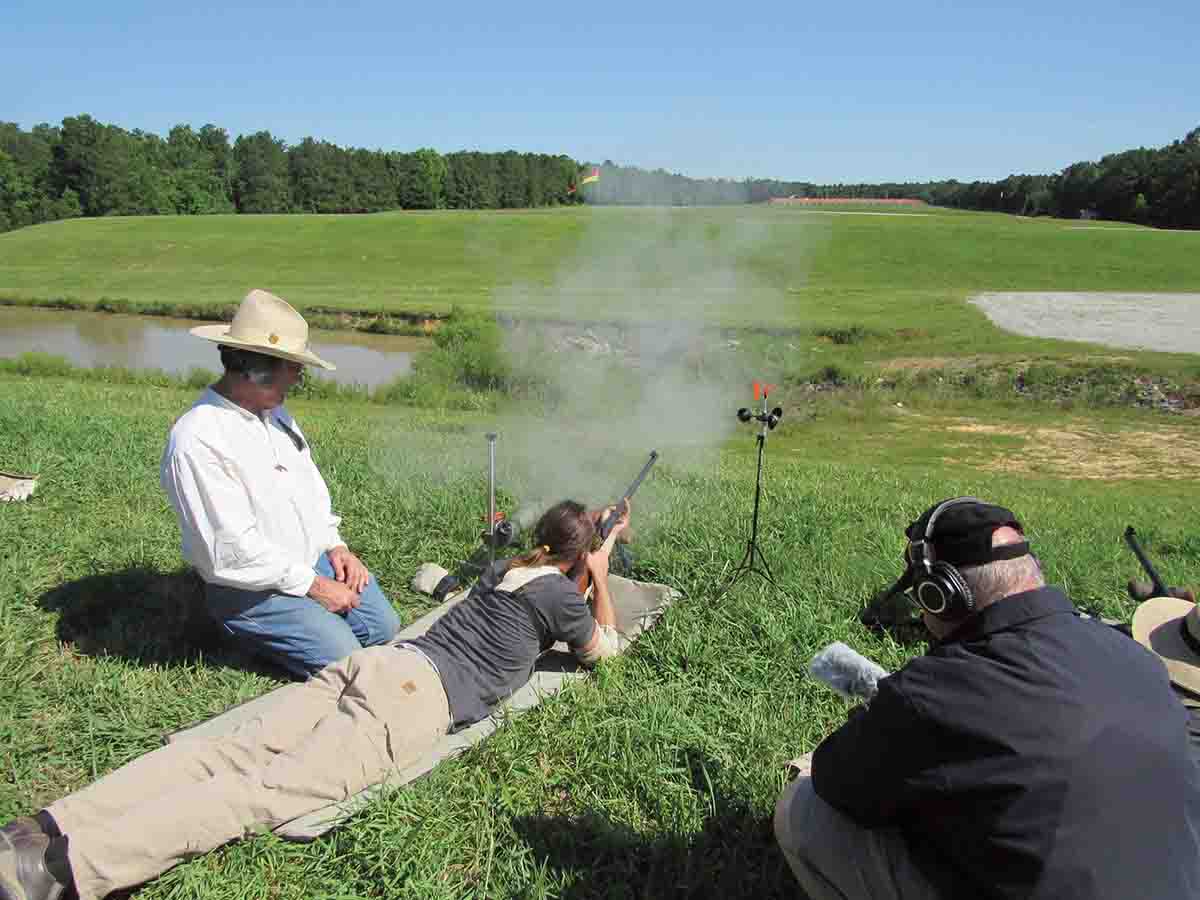
Long Range squads. There are eight shooters going to Australia. “We have good depth, so picking a four-man team for each event is a nice problem to have,” he added.
Family members of several shooters are going, and everyone is looking forward to renewing friendships made with foreign shooters. Competition will be tough as usual, especially with teams from South Africa, New Zealand and France. “We have lost several good shooters in recent years to illness or passing on, so we seriously need to recruit some new blood to help carry on the tradition of this wonderful and challenging sport,” Decker said.
Come to the Super Shoot!
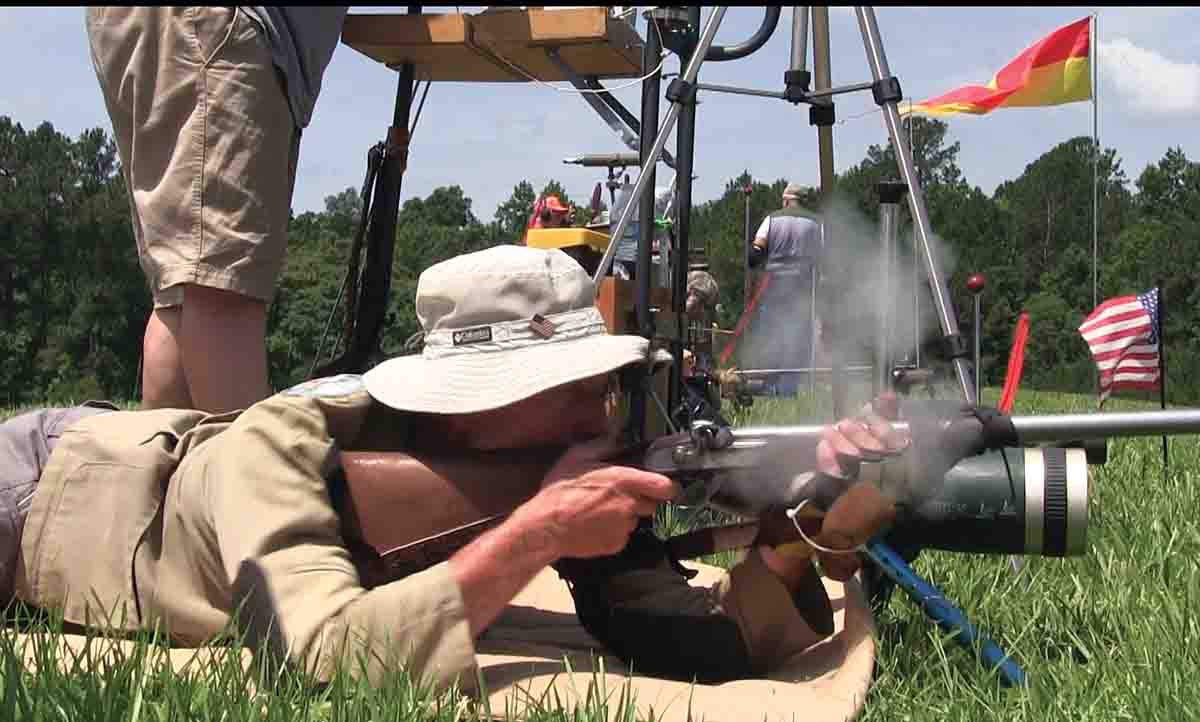
The trifecta of American Black Powder is coming! The USIMLT’s next match will be held near Phoenix, Arizona, on March 5-7, 2018, at the Ben Avery Range. The National Muzzle Loading Rifle Association Western Spring Nationals are scheduled February 28 through March 4, 2018 and the World 1,000-Yard Championships from March 8-10, 2018. That’s eleven continuous days of black powder shooting that will bring together shooters from all over the world!
The USIMLT segment of the Super Shoot will include matches at 300, 500, 600, 900 and 1,000 yards for all competitors. The four-man team events for the same yardages will follow. The matches will include muzzle loaders, cartridge rifles and vintage sniper rifles, all shooting at the same time, but at targets and under rules appropriate for each subgroup of rifles. Each subgroup will have their own awards. “There is no reason all long-range black powder shooters can’t work together,” says Decker. Our third day, March 7, will be a fun day dividing up shooters with different types of rifles into teams for a match at 1,000 yards.
For more information, contact Ed Decker; Email: onceuponatimetwo@gmail.com or call 865-256-7262.
What is the USIMLT?
The U.S. International Muzzle Loading Team (USIMLT) is an affiliate of the Muzzle Loaders Associations International Confederation (MLAIC). The MLAIC grew out of a number of British and European shooting clubs that
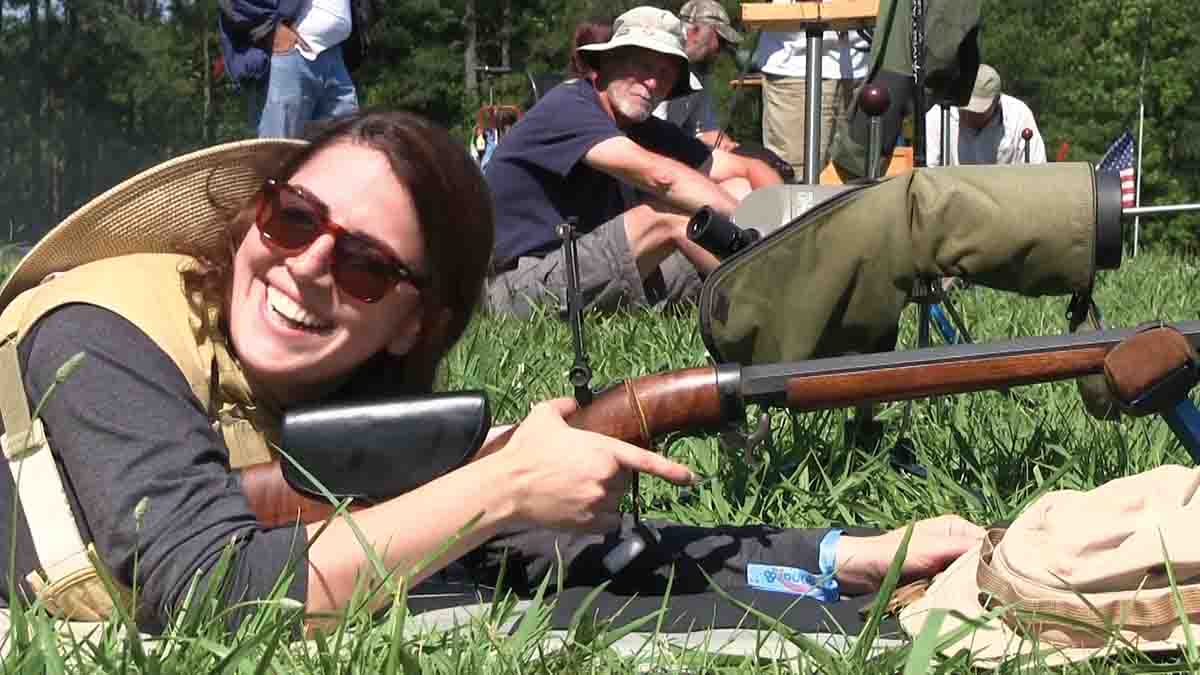
specialized in shooting original and reproduction muzzleloading arms. The U.S. became involved through the National Muzzle Loading Rifle Association. The first MLAIC World Championship took place in Spain in 1972. Today there are 32 member and correspondent nations spanning the globe from the U.S. and Canada, virtually all of Europe, to Japan, Australia and India in the Far East.
The MLAIC and USIMLT have two divisions, Long Range and Short Range. Long Range is strictly percussion lock rifles where a match typically includes 300, 500, 600, 900 and 1,000 yard stages. If the match is shot in meter distances the maximum range is 900 meters (980 yards).
Short-range matches include venues for pistols, smooth bore and rifled long arms, and shotgun. Pistol matches include events for matchlocks, flintlocks, percussion single-shots, and revolvers which include 25 and 50 yard/meter events. The same divisions are for long arms, which may also include 100 yard/meter events.
Equipment List:
Ray Hanson: .45 Billinghurst, 540-grain Steve Brooks mould, Creedmoor nose, 20:1 alloy, paper patch, 105 grains 1½ F Swiss, long-range, 90-grain midrange
Dave Gullo: .45 Ferris Rifle/Lee Shaver, 545-grain BACO Money bullet, 20:1 alloy, mini grease groove, 92 grains 1½ F Swiss, 1,290 fps
Ray Hopkins: .45 Gibbs (original), 547-grain 461 Leeth mold, paper patch, 20:1 alloy, Ciccone nose style, 101 grains Swiss 2 F for all ranges.
Kenn Heismann: .45 C. Ingram (original), 530-grain Higgenbotham mould final formed in a pound die designed by Dick Hoff, Paper patched dry, 95 grains Swiss 1½ F for 300, 500 and 600 yds, 100 grains for 600-1,200 yds.
Ike Legget: .45 Ferris Rifle/ Lee Shaver, 530-grain Rigby design paper patch bullet, Pure lead - Richard Corbin swage 92.5 grains 2 F Swiss
Dave Munch: .45 Rigby 1875 Rifle, original, 535-grain bullet Higgenbotham mould, Corbin swaged, 20:1 alloy, 95 grains Swiss 2 F powder, Wonder Wad
Richard L. Page: .45 Pedersoli Gibbs, 548-grain Money bullet, 30:1 alloy, grease groove, 100 grains Swiss 1½ F
Craig Faubion: .45 Rigby, 530-grain BACO mould, Elliptical nose, 20:1 alloy, paper patch, 93 grains 2 F Swiss
R. Christensen: .45 Pedersoli Gibbs, 500-grain Higginbotham mould, 30:1 alloy, 95 grains Swiss 1½ F
.jpg)
The American Creedmoor Cup & Midwest Regional Long Range Championship
Lodi, Wisconsin - June 2017
When I heard that Cliff Gregg and Mark Schuenke were planning to resurrect the American Creedmoor Cup and move the match to Lodi, Wisconsin, I cheered the proposal and assured them that I would attend if they were successful. I kept in touch with them through the laborious process, and it was not an easy row they hoed. But my money was on The Legends of Lodi to make it happen and sure enough, one day I received the entry forms as an attachment to an email from Cliff Gregg. The two-day American Creedmoor Cup would take place at the famous Winnequah Gun Club in conjunction with a two-day regional long-range championship. What more could a Black Powder Creedmoor shooter ask for?
On June 3rd, 2017, I climbed aboard my GMC Sierra, left Arizona and passed through New Mexico, four other states, crossed the Mississippi River at Dubuque, Iowa, and on to Wisconsin. Some thirty-odd hours of windshield time after leaving home in Arizona, I was at Lodi, Wisconsin. My Garmin GPS took me right to the front gate of the range.
.jpg)
After setting up our cots and unrolling our sleeping bags in the range house, we arose the next morning for practice day beginning with 1,000-yard targets. I got a lot of laughs when I walked out with my quilted goose down jacket on, as it was 48 degrees Fahrenheit. Soon targets were up, gear spread out on the firing points, and sighting-in practice began. By then I shed my jacket and got down to the business of figuring out sight settings and a strategy for this range.
The first revelation was that bullets were encountering approximately twice as much wind deflection during their flight to the target than what was evident on the flags or by the mirage. This observation held fairly close at 900 and 800 yards when the average conditions held, and elevations were duly noted. During sight-in, I watched the competitors on either side of me shoot at the same moment, and both of their shots went low. The flag immediately to our right showed an increase in intensity and change of direction when they shot before going back to average direction and intensity. A mental note was made to look out for that quick switch that apparently overrode the other average conditions and pushed both shots low. This was verified when I saw it happen again. What was further noted was the flags were fairly reliable and the mirage was not so much.
After the targets were put up and rifles cleaned, everyone gathered in the shade to socialize. It was then revealed that Wisconsin has a plethora of microbreweries; seems like everyone had a different brand of beer in their hands with labels I had not seen before. Good Samaritans were kind enough to share their favorites and not a single one was less than wonderful. It was during this sharing time that more was revealed about these veteran riflemen and the shooting on this range than I had learned all day. This tradition was looked forward to by everyone and was repeated after each of the five days.
Day One of the Creedmoor Cup dawned cool and once again the quilted goose down jacket gave the midwesterners another good
.jpg)
chuckle. I was squadded with “Chief” Ed Nezwirski and Jim Kluskens and had the opportunity to see the Remington Hepburn rifle that Jim built from scratch, using an original Hepburn action as a pattern. A job very well done and Jim shoots it quite well. He and Chief both shot paper-patched bullets. After Day Two, the rankings were close; at 1,000 yards, I was first with a 171-3X; at 900, Cliff Gregg posted first with a 177-1X; at 800 yards Mark Schuenke led the pack with a 179-3X.
Day Three was the first day of the Long Range Regional. Mariah, the Woman of the Wind, decided she was upset and would not settle down. In fact, she exacted revenge on one of the wind flagpoles by breaking it. The first task upon uncasing my rifle was to put a drop of oil on the threads of the windage adjustment of my rear sight, making sure it moved freely. Similarly, on Day Two of the regional, Mariah huffed and puffed and blew bullets around until one shooter put his rifle in the case during record fire exclaiming, “The darn thing won’t put the bullets where I want them to go!”
After Day Two of the Long Range Regional, the rankings were as follows: at 1000 yards I was first with a total aggregate of 165-2X; Cliff Gregg was first at 900 yards with a 178-3X. I lucked out by one point at 800 for first with a 185-4X. This was due solely to the great target service and spotting by Cliff Gregg and Mark Schuenke. Either of them could have easily won had they not been so busy providing a first-class match experience for those in attendance.
Several shooters were handicapped by equipment malfunctions. One shooter had a broken scope mount and two broken firing pins. Another had the trigger fly come loose, blocking the hammer fall. Two riflemen were impaired by sudden health concerns that kept them away from the firing line.
As in most matches, things happen that make the match special, and you are glad that you were there to see it in person. Such was the case on firing point 11. Due to shooters having to drop out unexpectedly, one firing point had two shooters instead of three. This was (accidently, I am sure) referred to as, “We only have one odd couple shooting.” Barbara Walters, who was not shooting due to recent surgery, spotted for the “odd couple,” who ended up 4th and 5th overall at the end of two days of shooting. One was Dave Zizzo who placed 4th in the grand aggregate, shooting a .40-65 and was second in the 1,000-yard aggregate with a 157-3X.
Cliff and Mark asked me if I would be back for Creedmoor Cup 2018. I told them that if I am at all able, I will be there and thanked them for a wonderful match experience.
After the awards ceremony, it was time to pack up and head back to Arizona. Coming and going both ways, I drove all day long on Sunday. I stayed off of the Interstates and went through the communities. It seemed like every church I passed had a full parking lot. I noticed many houses flying the American flag. Everywhere I looked, as far as the eye could see, was cultivated land. Once, I saw three combines going through a wheat field side by side. Silos must have been full because they were blowing wheat out on the ground and covering it with tarps as I headed toward Wisconsin. On the way back, farmers had uncovered the mountains of wheat and were putting it in long-grain trucks with front-end loaders. I saw train after train with empty hopper cars pulling alongside small communities on sidings. I arrived home in Arizona with a very good feeling about what I had seen, both going and coming, and with no more inconvenience than 190 empty .45-90 cases to clean. - Zack Taylor
Equipment List
Jim Kluskens: .45-70 Kluskens/Remington Hepburn, 1:18 twist, Badger barrel, 520-grain Kluskens paper-patch bullet, 1:16 alloy, 83 grains 1½ Fg Swiss powder, .060 poly wad, Remington 2½ primer, Starline cases, Distant Thunder sights, rifle weight 14.5 pounds. Rifle wiped with one wet, one dry pro-Shot patch, wiping solution is 1:10 water soluble oil
Cliff Gregg: .45-90 1885 Winchester High Wall, 32:16 twist, Ron Long barrel, 525-grain BACO Money M4 custom band bullet, 1:16 alloy, .060 poly wad, 82 grains 1½ Fg Swiss powder, Federal GM150 primer, Starline cases, Distant Thunder sights, Klusken aperture, Rifle weight 11 pounds. Rifle wiped with two wet cotton patches, wiping solution is M-Pro7
Zack Taylor: .45-90 Remington Hepburn/John King, 1:18 twist, 34-inch Badger barrel, 540-grain BACO 459542M3 bullet, 1:16 alloy, homemade lube, .060 poly/.025 milk carton wad, 83 grains 1½ Fg Swiss powder, Federal 150M primer, Starline cases, MVA sights, aperture insert, rifle weight 11 pounds, 12 ounces. Rifle wiped with BACO bore wipes and one wet 2¼-inch cotton patch
Dave Zizzo: .40-65 Wyoming Armory Winchester High Wall, 1:16 twist, Bartlein barrel, 400-grain BACO No. 4 bullet, 1:20 alloy, Matthews lube, .060 poly wad, 59 grains 1½ Fg Swiss, Remington 2½ primer, Starline cases, MVA sights, aperture insert, rifle weight 11 pounds, 10 ounces. Rifle wiped with 2¼-inch patch, wiping solution is Prestone RV antifreeze
.jpg)
.jpg)
.jpg)
.jpg)
